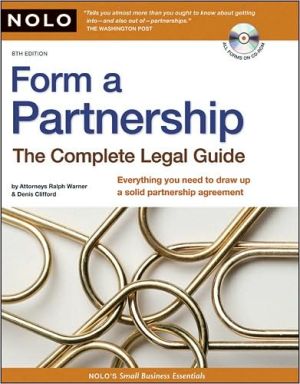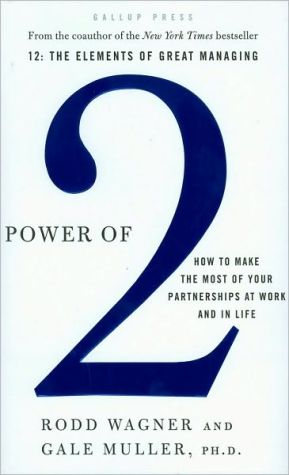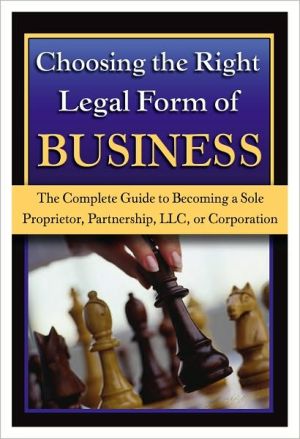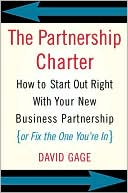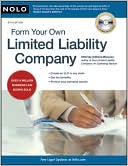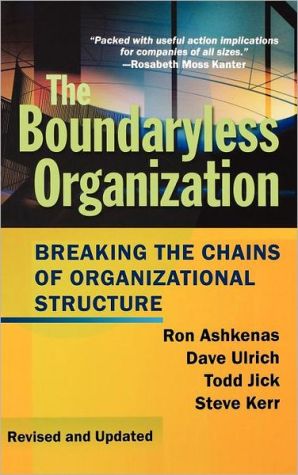Form A Partnership: The Complete Legal Guide
What's involved in forming a partnership? How does one write a partnership agreement? This helpful book covers all the important partnership issues such as cash and property contributions, profit sharing, tax liability and buyouts. Readers can take advantage of the standard partnership clauses provided or create their own customized agreement. All the forms for creating a partnership agreement are provided, both on CDROM and as tearouts.
Search in google:
Everything you need to create a business partnership with friends or family. Los Angeles Times Detailed advice (and plenty of sample forms, worksheets and agreements) on everything...
Introduction\ \ If you're considering going into business with a friend, or several friends, you're joining in a basic American dream-running your own show, being your own boss, and hopefully gaining some control over your economic destiny.\ \ Before you take the plunge, however, you should take a step back and consider whether forming a partnership makes sense. We mean this in two ways. First, are you ready to start a shared business of any kind? While there are great benefits to shared ownership, it can also create stress-and it will definitely require you to work very closely with your co-owners. Before you get started, it makes good sense to take a very close look at your own willingness to be that intimately involved with your prospective partners.\ \ Second, if you decide that you want to start a shared-ownership business, what legal form should that business take? A partnership is only one of a handful of ways you can structure a shared ownership business. Before you invest the time and energy drafting a partnership agreement, you should carefully consider whether another ownership structure-such as a corporation or a limited liability company-might better suit your business.\ \ This chapter will help you answer both questions. If you decide, after careful consideration, that forming a partnership is the best way to realize your business and personal goals, the rest of this book will help you draft a partnership agreement that will serve your business well for years to come.\ Sharing Ownership of a Business\ \ The advantages of having one or more co-owners can be tremendous, but so can the headaches of trying to make group decisions, agree on businessgoals, run your company together, and distribute the work, profits, and debt fairly. Whether shared ownership is right for you depends both on your own personality and on the partners you've chosen.\ Advantages and Drawbacks\ \ Shared ownership has many benefits. The chemistry and spirit of two, three, or more minds working together can often produce exciting results. There's more energy and enthusiasm, and-at least as important-more cash, skills, and resources. And it's a lot easier to arrange for time off if you have partners than if you're trying to run a business all by yourself.\ \ But for all of those who dream of doing their own thing-and who hasn't?-only a relatively small number will be committed (or nutty) enough to invest the love and labor necessary to get a small business off the ground. Those who do will almost inevitably go through periods of stress, and their survival will depend on their ability to quickly and competently master all sorts of unfamiliar skills and tasks. In a partnership business, there are also the stresses and risks that can come with shared ownership. Money can be incendiary stuff. Before you decide to throw in your financial lot with others, you need to make sure you're willing and able to become involved that intimately with each other.\ \ In a shared business, your co-owners will make decisions that directly affect your life. Of course, there are steps you can take to put some limits on this, such as requiring decisions to be made by the whole group or limiting the authority of one owner to act for others. But ultimately, sharing a business requires you to give up some control. Shared ownership allows you to share the burdens of your business, but it also requires you to share the responsibilities. If that doesn't sound like you, a shared-ownership business probably isn't the right call.\ Choosing the Right Partners\ \ The most important assets of any shared business are the co-owners' competence, determination to work hard, and the trust they have in one another. Of course, your business partners must share your dream, but they must also be willing to share the work. Of course, you and your partners should get along well personally, but that's not enough. You must also have compatible work styles, have similar expectations about how much each of you will do for the business, and have the same goals for your business's future.\ \ Partnerships are (very) human enterprises. While we can't tell you exactly who you should pick as a partner, we can tell you that not every friendship- or every romantic relationship-makes a good business partnership. Our experience has taught us that there are a few questions prospective partners should consider before throwing in their lot with one another:\ \ * Do you all understand and agree that you're going to run a business with the aim of making a decent profit? Any money-making enterprise qualifies as a business. If any would-be partners are nonbusiness types who simply aren't comfortable with that, you (and they) don't want to be part of the same partnership.\ * How long have you known each other? We've seen some new friendships crumble under the stress of running a business together. Don't enter any partnership casually.\ * Are all prospective partners roughly on the same economic footing? If not, how do you feel about the possibility that some partners' decisions may be based not on the business's economic realities, but on their own outside financial resources or needs?\ * How's your chemistry? There are no rules at all here. Sometimes, people with different temperaments work out very well as partners. And sometimes, people who are longtime friends with very similar personalities can't develop a harmonious business relationship. Probably, the best you can do is ask yourself whether you can imagine being in a close business relationship with your prospective partners ten or more years from now. If you can't, think twice about going forward.\ \ A Personal Note\ \ If you're feeling a bit overwhelmed about starting a shared business, you're certainly not alone. But we're confident that you'll find-as we have-that along with the hard work and unavoidable stresses of running a shared business, there's a lot of excitement and freedom as well.\ \ Both of us grew up on the East Coast, went off to college, and emerged, like so many others, unsure about "what we wanted to do." We considered lots of choices; both of us drifted to law school with the vague hope that the law would give us some skills useful in making the world a better place. How we each became disillusioned with that dream is another story; the point here is that through all of our dreaming and planning, neither of us ever imagined that we'd wind up as proprietors of small businesses, full-fledged members of the "free enterprise system." But that's what happened. We've experienced both great satisfaction and some very real pain in running our own shops. We've been through our complete beginner stage and have made most of the routine mistakes, as well as pioneering some lulus. Somehow, we've survived it all to realize that doing our own thing at Nolo gives us a sense of freedom and self-worth, at the same time that we make a good living-a combination that's hard to match in this increasingly bureaucratized world.\ \ We know we are not alone in finding a measure of satisfaction in jointly participating in a small business. In the process of putting this book together, we talked to many people who have successfully created their own small business partnerships. We've been told time and again about the satisfaction, and even joy, derived from providing a product or service that genuinely interests the provider and benefits the consumer. We've also learned a lot about how people relate to-and may even gain some satisfaction from-the tough competition that's so much a part of the world of small business, where survival depends on your ability to offer something that people really want and need. And most of all, we've been reminded constantly that although money is important, it's not usually the primary reason people organize their own businesses. It's gratifying to talk with partners more concerned with the quality of work and a sensible life than the top dollar. Happily, we've found that integrity and creativity- even altruism-are alive and well in small business America.\ Business Structure Options\ \ There are five common legal forms of business ownership:\ \ * partnership\ * sole proprietorship\ * corporation\ * limited liability company, and\ * limited partnership.\ \ (Some states have distinct subcategories of these five, especially partnerships. For example, there's a creature called a "mining partnership" used for mining and oil ventures in some states. In this chapter, we'll just concern ourselves with the basic forms.)\ \ To help you choose the business structure that best suits your needs, this chapter explains the legal and practical consequences of each option. Of course, our emphasis is on the partnership form, but don't assume that it must be the right one for you without exploring your alternatives. We've received letters from readers of earlier editions telling us that after reading these materials, they decided to form a small corporation or a sole proprietorship. That's great; the time to consider your options is here at the start. Once you've created your legal form, it takes some time and trouble to change it.\ Partnerships\ \ In this section, we give you a quick look at the nature of partnerships, so that you can compare them to corporations, limited liability companies, and sole proprietorships. Later in this chapter, we'll explore the partnership legal form in more depth.\ \ Here are five key points about partnerships:\ \ 1. A partnership is a business owned by two or more people.\ 2. Each partner can perform all acts that are necessary to operate the business, including hiring employees and spending or borrowing money. (However, you can put some limits on a partner's authority, as explained in "A Closer Look at Partnerships," below.) Each partner is personally liable for all debts incurred by the business. This is a vital reason why your partners must be trustworthy. If a creditor has a claim against your partnership and the partnership doesn't have enough assets to satisfy that claim, the personal assets of any partner can be taken to pay the business debts.\ 3. Partners share in profits or losses, in whatever proportion they've agreed on. Partnerships themselves don't pay taxes (although they do file an annual tax form). The partners report their share of profits or losses on their individual tax returns, as part of their regular income.\ 4. Partnerships begin when two or more people form a business. Although technically a partnership ends if one partner leaves, you can agree at the beginning that the partnership business will continue to be run by the remaining partners, if there are any. If you want the business to continue after a partner leaves-and almost all partnerships work this way-you'll need to work out what will happen to the interest of the departing partner. Who can, or must, buy that interest? How will you determine a fair price for that interest? (See Chapter 5.)\ 5. The owners normally have a written partnership agreement specifying their respective rights and responsibilities. The purpose of this agreement is to cover all major issues that may affect the partnership, from the manner of dividing profits and losses to management of the business to buyout provisions in case a partner leaves or dies. This agreement does not have to be filed with any government agency, and no official approval is required to start the partnership. (There are different rules for limited partnerships; see Chapter 9.)
\ Accounting TodayIf you're setting up shop with other owners... you'll find all you need to know in Form a Partnership.\ \ \ \ \ San Francisco ExaminerDetails what the agreement should include... a step-by-step guide that pilots readers through the partnership agreement.\ \ \ Los Angeles TimesDetailed advice (and plenty of sample forms, worksheets and agreements) on everything...\ \ \ \ \ Tribune Media ServicesIf you think you need a sidekick... the seventh edition of a well-regarded book has just come out -- Form a Partnership: The Complete Legal Guide.\ \ \ \ \ Washington PostA blockbuster paperback that tells you almost more than you ought to know about getting into -- and also out of -- partnerships.\ \
